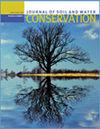黄土高原降雨侵蚀力变化格局及其对泥沙负荷的影响——以典型流域为例
IF 2.6
4区 农林科学
Q2 ECOLOGY
引用次数: 0
摘要
土壤侵蚀的普遍发生反映了地表生态环境的加速恶化。降雨侵蚀力的时空变化是水土流失的关键驱动因子,特别是在黄土高原地区。以黄土高原汾河流域为例,选取1962—2019年逐日降水资料进行研究。利用基于日降雨量的降雨侵蚀力模型,研究了降雨侵蚀力的变化规律。此外,还评价了降雨侵蚀力对泥沙负荷的影响,并讨论了泥沙负荷变化的可能原因。结果表明,12个气象站的年降雨侵蚀力变化不显著(p < 0.05)。20世纪80年代以前,流域年平均降雨侵蚀力的下降可能是导致年输沙量减少的主要原因,而20世纪80年代以后,特别是1993年前后,拦河坝的建设可能是导致年输沙量减少的主要因素。1999年以后,植被的增加是年输沙量减少的主要原因。汾河流域是黄土高原典型的流域,研究该区降雨侵蚀力及其对泥沙的影响,可为黄土高原进一步的生态建设和水土流失治理提供有益的参考。本文章由计算机程序翻译,如有差异,请以英文原文为准。
The changing pattern of rainfall erosivity and its impact on sediment load in the Loess Plateau, China: A case study of a typical watershed
The widespread occurrence of soil erosion reflects the accelerated deterioration of the surface ecological environment. The spatiotemporal variation of rainfall erosivity is the key driving factor for soil erosion by water, especially in the Loess Plateau in China. The Fenhe River basin in the Loess Plateau was selected as a case study based on the daily rainfall data from 1962 to 2019. Using a rainfall erosivity model based the daily rainfall, we studied the changing pattern. Furthermore, the impact of rainfall erosivity on sediment load was evaluated, and the possible causes for changes in sediment load were discussed. The results showed that the annual rainfall erosivity of the 12 weather stations experienced an insignificant change (p > 0.05). Moreover, before the 1980s, the decrease in annual watershed average rainfall erosivity may be the main reason for the decrease in annual sediment load, while after the 1980s, the construction of check dams may be the main factor leading to annual sediment load reduction, especially around 1993. However, the increase of vegetation was a main reason for the reduction of annual sediment load after 1999. Given Fenhe River basin as a typical watershed of the Loess Plateau, the study of rainfall erosivity and its impacts on the sediment in this area can provide a useful reference for further ecological construction and soil erosion control in the Loess Plateau.
求助全文
通过发布文献求助,成功后即可免费获取论文全文。
去求助
来源期刊
CiteScore
4.10
自引率
2.60%
发文量
0
审稿时长
3.3 months
期刊介绍:
The Journal of Soil and Water Conservation (JSWC) is a multidisciplinary journal of natural resource conservation research, practice, policy, and perspectives. The journal has two sections: the A Section containing various departments and features, and the Research Section containing peer-reviewed research papers.

 求助内容:
求助内容: 应助结果提醒方式:
应助结果提醒方式:


